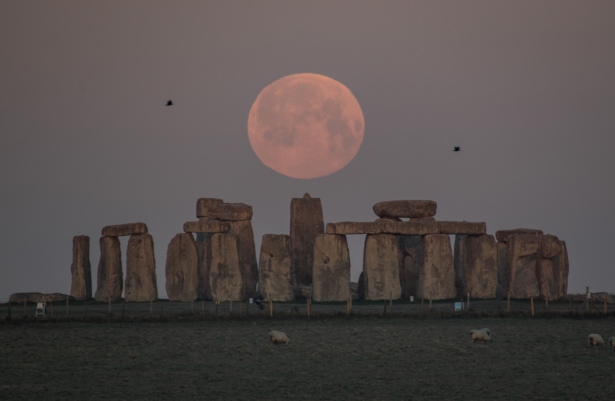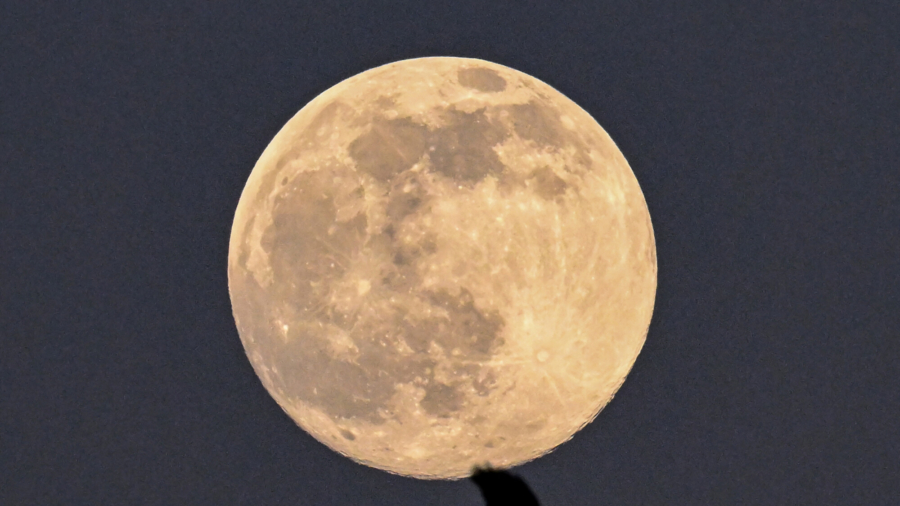The final full moon of winter will light up the sky this week, and it coincides with another special opportunity for sky-watchers.
Named the worm moon by Native American tribes in the 18th century in reference to different creatures emerging from their winter hideouts to welcome spring, the March moon will reach peak illumination at 7:42 a.m. ET Tuesday, March 7, according to the Old Farmer’s Almanac. But someone looking up at the right moment could catch a stunning planetary phenomenon, too.
“What is a little more interesting now, and also visible tonight and this week, are the close and prominent positioning of Venus and Jupiter in the western sky right after sunset,” said Mike Hankey, operations manager for the American Meteor Society, via email. “The astronomical word for this is ‘conjunction.’ These planets will be setting as the moon is rising, so they are only visible for about an hour at sunset, near the western horizon.”
People who get a little rain on Monday or Tuesday night might also get to spot a moonbow, which is like a solar rainbow but produced by moonlight when it’s refracted through water droplets in the air, according to the Old Farmer’s Almanac. Moonbows only happen when a full moon is low in the sky, so look for them after sunset when the sky is dark.
The worm moon isn’t your last chance to catch a special space or sky event. Here are the full moons, eclipses, and meteor showers to watch out for this year.
Full Moons and Supermoons
Most years have 12 full moons, but 2023 will have 13, with two—which are supermoons—happening in August. Supermoons are brighter and closer to Earth than normal and therefore appear larger in the sky.

Here’s the list of full moons remaining in 2023, according to the Old Farmer’s Almanac:
April 6: Pink moon
May 5: Flower moon
June 3: Strawberry moon
July 3: Buck moon
August 1: Sturgeon moon
August 30: Blue moon
September 29: Harvest moon
October 28: Hunter’s moon
November 27: Beaver moon
December 26: Cold moon
Lunar and Solar Eclipses
There will be two solar eclipses and two lunar eclipses in 2023.
A total solar eclipse—when the moon moves between the sun and Earth, blocking the sun—will be visible to people in Australia, Southeast Asia, and Antarctica on April 20.
An annular solar eclipse will occur on October 14 and be visible across North, Central, and South America. This is when the moon passes between the sun and Earth when the moon is at or near its farthest point from Earth—making the moon appear smaller than the sun and creating a glowing ring around the moon.
When viewing solar eclipses, wear proper eclipse glasses to avoid eye-damaging sunlight.
A penumbral lunar eclipse—when the moon moves through the penumbra, the faint, outer part of Earth’s shadow—will occur on May 5 for those in Africa, Asia, and Australia.
On October 28, a partial lunar eclipse will be viewable by people in Europe, Asia, Australia, Africa, parts of North America, and much of South America. That’s when the sun, Earth, and moon don’t completely align, so only part of the moon passes into shadow.
Meteor Showers
There are 11 more meteor showers to catch this year, and they are most visible from late evening until dawn in areas unaffected by light pollution.
Here are their peak dates:
Lyrids: April 22–23
Eta Aquariids: May 5–6
Southern Delta Aquariids: July 30–31
Alpha Capricornids: July 30–31
Perseids: August 12–13
Orionids: October 20–21
Southern Taurids: November 4–5
Northern Taurids: November 11–12
Leonids: November 17–18
Geminids: December 13–14
Ursids: December 21–22
The-CNN-Wire
™ & © 2023 Cable News Network, Inc., a WarnerMedia Company. All rights reserved.

